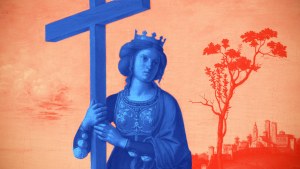Lenten Campaign 2025
This content is free of charge, as are all our articles.
Support us with a donation that is tax-deductible and enable us to continue to reach millions of readers.
One of the most remarkable figures found in the annals of Byzantine history is Kassia. She was a prolific composer, a hymnographer, and a poet. Her contributions to Byzantine music are simply unparalleled. She is the only known woman whose compositions are part of the Byzantine liturgy. About 50 of her hymns have survived – although there are still some questions regarding their authenticity and attribution, since most of the manuscripts are anonymous.
Kassia was born into a wealthy family in Constantinople around the year 810. She was known for her beauty and intelligence. Her story met that of Emperor Theophilos in a dramatic way during a “bride show.” This was a tradition whereby a Byzantine emperor would choose his bride by presenting a golden apple to his preferred candidate – as if evoking the Judgment of Paris.
Theophilos was smitten by Kassia and approached her with a remark referencing Eve’s transgression. “It was a woman who brought forth the baser things,” the emperor said. Kassia quickly replied: “And through a woman [came forth] the better [things],” alluding to the Incarnation of Christ through the Virgin Mary. The comeback didn’t sit well with the emperor, who chose Theodora instead.
Kassia’s life took a different path when she founded a convent in the west of Constantinople around 843, becoming its first abbess. Some biographers suggest she chose monastic life out of bitterness after Theophilos’ rejection, but a letter by Theodore the Studite suggests she had spiritual motivations.
Her convent was closely connected to the nearby monastery of Stoudios, which was crucial in preserving her works through re-editing Byzantine liturgical books in the 9th and 10th centuries.
Kassia’s life wasn’t easy. Theophilos was a strong opponent of icons and he persecuted her for defending the veneration of sacred images. Despite being beaten, she kept her convictions. She was even quoted as saying, “I hate silence when it’s time to speak.” Even when faced with threats, she remained resilient.
After Theophilos died in 842, his son Michael III became emperor with Empress Theodora as regent, putting an end to the second period of iconoclasm.
Kassia later went to Italy for a while and eventually settled on the Greek island of Kasos, where she died between 867 and 890. It’s thought that her tomb is in Panaghia.
Kassia’s legacy as a composer is impressive. She wrote numerous hymns that are still used in Byzantine liturgy today. The great Theodore the Studite recognized Kassia’s learning and literary style, as her works blend spiritual depth with classical Greek influences.
Kassia is also regarded as a saint in Orthodox traditions, and her legacy as a pioneering female composer in Byzantine liturgy is still influencing contemporary musicians, liturgists, and believers.



